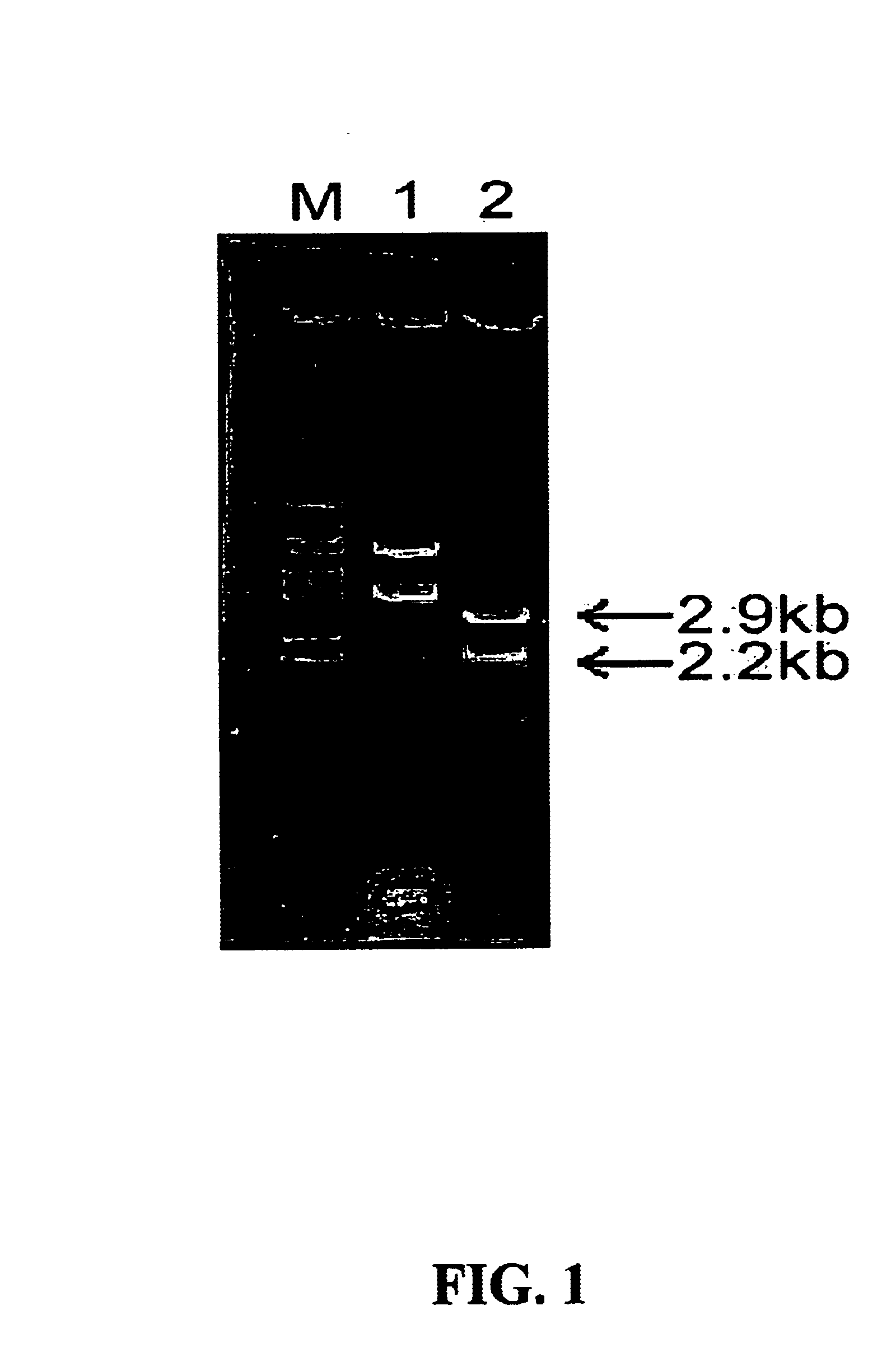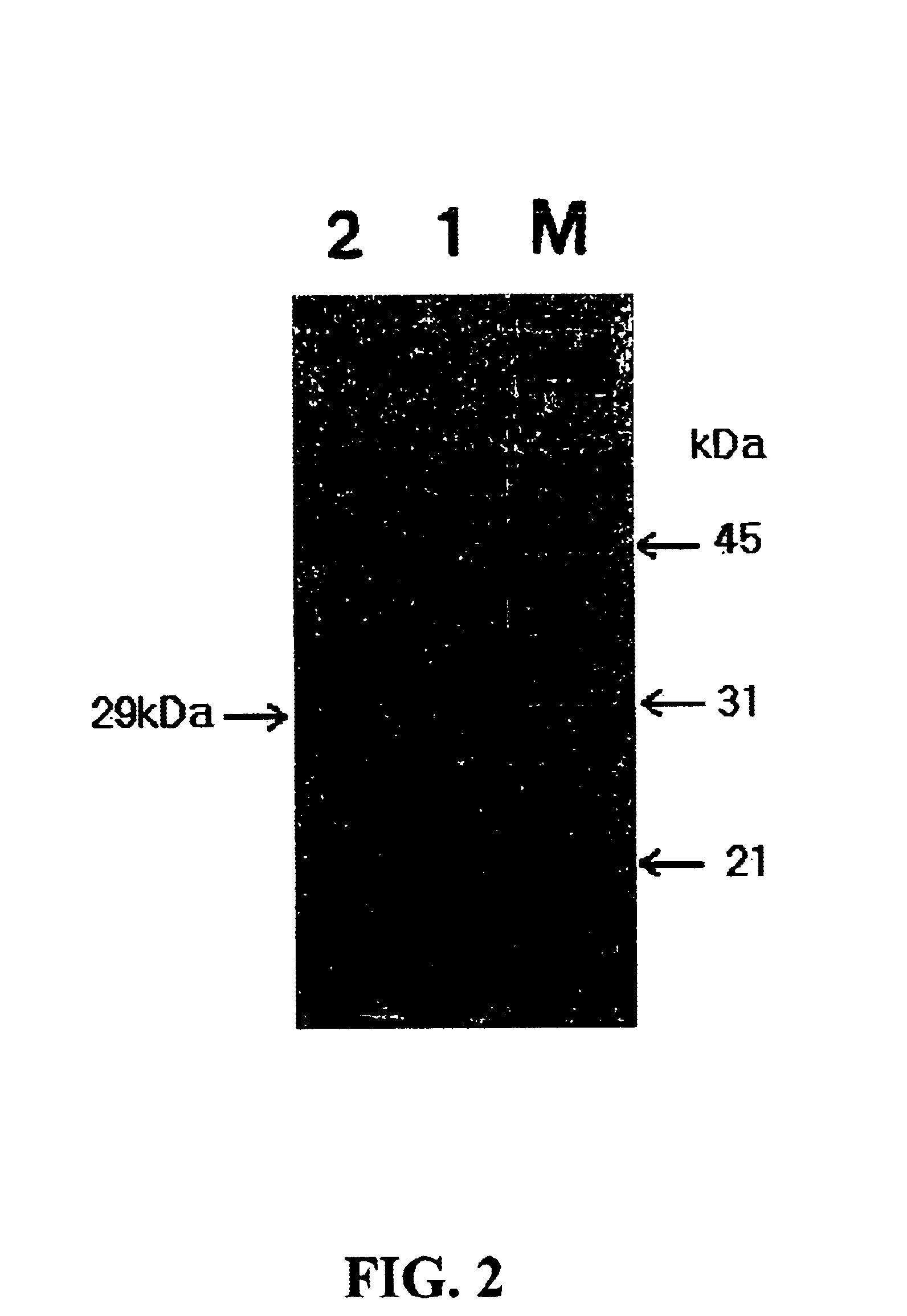Recombinant plasmid pDSBCm, microorganisms transformed therewith, and method for producing an alkaline protease VapK
- Summary
- Abstract
- Description
- Claims
- Application Information
AI Technical Summary
Benefits of technology
Problems solved by technology
Method used
Image
Examples
example 1
Cloning of the Alkaline Protease Gene Vapk
After culturing the Vibrio metschnikovii KS1 in a LSC medium with the composition of Table 1 at 30° C., the grown cells were harvested and disruptured. The disruptured solution was centrifuged at 6,000 rpm and the supernatant was collected. The chromosomal DNA of Vibrio metschnikovii KS1 was purified from the supernatant and partially digested with Hind III. The fragment was inserted into a vector pKF3 to clone 2.9 kb alkaline protease gene. The resulted recombinant plasmid vector was designated as pSBCm. The recombinant plasmid vector pSBCm was digested with Hind III and subjected to electrophoresis on 1% agarose gel. After electrophoresis, the agarose gel was stained with ethidium bromide as a staining agent. As a result of the above agarose gel electrophoresis, it was verified that the alkaline protease gene was cloned into a plasmid vector. (FIG. 1)
TABLE 1Composition of LSC mediumComposition of LSC mediumAmount (g / L)Tryptone10Yeast extra...
example 2
Isolation and Purification of the Alkaline Protease
The strain Vibrio metschnikovii KS1 cultured in the above LSC medium of example 1 was centrifuged to obtain the supernatant that was used as an enzyme sample of the invention. After culturing the transformed strain E. coli pSBCm, the grown cells were harvested and disruptured. The disruptured solution was centrifuged at 6,000 rpm to obtain the supernatant that was also used as another enzyme sample of the invention. Each said enzyme sample was added into a buffer solution consisting of 6M urea, 2.5% sodium dodecyl sulfate, 5% (w / v) beta-mercaptoethanol, 0.01M tris-HCl, pH 6.8, 10% (w / v) glycerol, and 0.002% bromophenol blue in the same ratio. The mixture was heated in boiling water for 15 minutes and subjected to electrophoresis. The finished gel was stained with 0.05% Coomassie Brilliant Blue R-250 and was destained with a mixture of 50% methanol and 10% acetic acid. As a result of SDS-PAGE shown in FIG. 2, a band of the 29 kDa alk...
example 3
Activity Assay of Alkaline Protease VapK on Skim Milk Agar
The strain Vibrio metschnikovii KS1 cultured in the above LSC medium of example 1 was centrifuged at 6,000 rpm for 10 minutes to obtain the supernatant that was used as an enzyme sample of the invention. After growth of a transformed strain E. coli pSBCm, the grown cells were harvested and disruptured. The disruptured solution was centrifuged at 6,000 rpm to obtain the supernatant that was also used as another enzyme sample of the invention. Each said enzyme sample was added into a buffer solution consisting of 50 mM phosphate buffer, pH 7.0, 10% (w / v) glycerol and 0.002% bromophenol blue in the same ratio and the mixture was subjected to native gel electrophoresis. The finished gel was placed on an agar plate containing skim milk and a 50 mM sodium carbonate buffer, pH 10.0 to analyze the activity of the alkaline protease. As a result shown in FIG. 3, the activity of the alkaline protease was verified.
PUM
| Property | Measurement | Unit |
|---|---|---|
| Stability | aaaaa | aaaaa |
Abstract
Description
Claims
Application Information
 Login to View More
Login to View More - R&D Engineer
- R&D Manager
- IP Professional
- Industry Leading Data Capabilities
- Powerful AI technology
- Patent DNA Extraction
Browse by: Latest US Patents, China's latest patents, Technical Efficacy Thesaurus, Application Domain, Technology Topic, Popular Technical Reports.
© 2024 PatSnap. All rights reserved.Legal|Privacy policy|Modern Slavery Act Transparency Statement|Sitemap|About US| Contact US: help@patsnap.com










